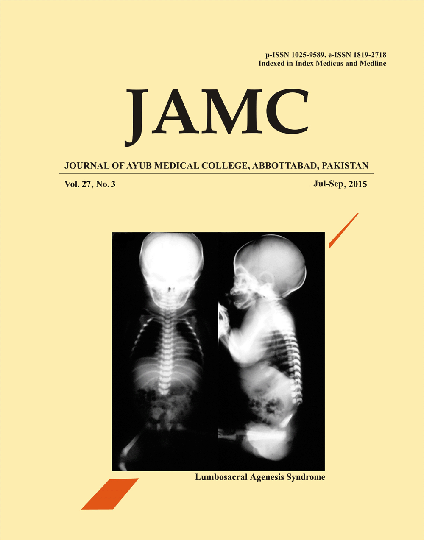HEALTH RELATED QUALITY OF LIFE IN SCHOOL GOING ADOLESCENTS OF KHYBER PAKHTUN-KHWA PAKISTAN
Abstract
Background: In several countries health related quality of life (HRQoL) scales have been used for adolescents, to assess the impact of disease. Health related quality of life scales are used on a range of different domains: physical, psychological, social and spiritual focusing on personal life including the concept of the World Health Organization definition of health. Methods: Health related quality of life in adolescent going to schools in the cantonment area of Peshawar garrison was assessed in a cross sectional descriptive study. Data was gathered by using a self-administered questionnaire (Kiddo-KINDL-R Questionnaire), previously tested to assess quality of life across six dimensions of health i.e. Physical and emotional well-being, self-esteem, family, social and school. Results: A total of 300 students of average age 13.41±1.34 years, with 145 (48.3%) females. Mean (SD) of total QoL score was 86.98 (12.86). The mean total scores were 86.28±12.34 and 87.64±13.34 for girls and boys, respectively. Conclusion: On the whole quality of life scores of the adolescent are good in the four dimensions. Special attention is needed towards the school environment, as majority of the participants are not satisfied with their schools. Similarly self-esteem scores are also low in the majority. However it is encouraging that most of the participants have scored highest scales in dimensions of family and physical health. Any effort to assess quality of life of the adolescents at the national level will give better view of quality of life of our youthReferences
Bullinger M, Ravens-Sieberer U. Health related quality of life Assessment in children: A review of the literature. Eur Rev Appl Psychol.1995;45(4):245-56.
The World Health Organization Quality of Life Assessment (WHOQOL): Position paper from the World Health Organization. Soc Sci Med 1995;41(10):1403-9.
Saracci R. The World Health Organization needs to reconsider its definition of health. BMJ 1997;314(7091):1409-10.
Bisegger C, Cloetta B, von Rueden U, Abel T, Ravens-Sieberer U. Health related quality of life: gender differences in childhood and adolescence. Soz Praventimed 2005;50(5):281-91.
Bullinger, M. Assessing health related quality of life in medicine: an overview over concepts, methods and applications in international res earch. Restor Neurol Neurosci 2002;20(3-4):93-101.
Schumacher J, Klaiberg A, Bra'hier E. Diagnostik von Lebensqualita't and Wohlbefinden-Eine Einfuh rung. In: Schumacher J, Klaiberg A, Bra'hier E edu. Diagnostische Verfahren zu Lebensqualita't und Wohlbefinden. Gottingen: Hogrefe 2003;9-24.
Ravens-Sieberer U, Torsheim T, Hetland J, Volleberg W, Cavallo F, Jericek H, et al. Subjective health symptom-load and quality of life of children and adolescents in Europe. Int J Public Health 2009;54:151-9.
Neumann PJ, Goldie SJ, Weinstein MC. Preference-based measures in economic evaluation in health care. Annu Rev Public Health 2000;21:587-611.
Hyland ME. Quality-of-life measures as providers of information on value-for-money of health interventions. Comparison and recommendations for practice. Pharmacoeconomics 1997;11(1):19-31.
Wee HL, Lee WW, Ravens-Sieberer U, Erhart M, Li SC. Validation of the English version of the KINDL generic children's health-related quality of life instrument for an Asian population-results from a pilot test. Qual Life Res 2005;14(4):1193-1200.
Wee HL, Ravens-Sieberer U, Erhart M, Li SC. Factor structure of the Singapore English version of the KINDL® children quality of life questionnaire. Health Qual Life Outcomes 2007;5:4.
Yamaguchi N, Poudel KC, Poudel-Tandukar K, Shakya D, Ravens-Sieberer U, Jimba M. Reliability and validity of a Nepalese version of the Kiddo-KINDL in adolescents. Biosci Trends 2010;4(4):178-85.
Awasthi S, Agnihotri K, Chandra H, Singh U, Thakur S. Assessment of Health-Related Quality of Life in school-going adolescents: validation of PedsQL instrument and comparison with WHOQOL-BREF. Natl Med J India 2012;25(2):74-9.
Downloads
Published
How to Cite
Issue
Section
License
Journal of Ayub Medical College, Abbottabad is an OPEN ACCESS JOURNAL which means that all content is FREELY available without charge to all users whether registered with the journal or not. The work published by J Ayub Med Coll Abbottabad is licensed and distributed under the creative commons License CC BY ND Attribution-NoDerivs. Material printed in this journal is OPEN to access, and are FREE for use in academic and research work with proper citation. J Ayub Med Coll Abbottabad accepts only original material for publication with the understanding that except for abstracts, no part of the data has been published or will be submitted for publication elsewhere before appearing in J Ayub Med Coll Abbottabad. The Editorial Board of J Ayub Med Coll Abbottabad makes every effort to ensure the accuracy and authenticity of material printed in J Ayub Med Coll Abbottabad. However, conclusions and statements expressed are views of the authors and do not reflect the opinion/policy of J Ayub Med Coll Abbottabad or the Editorial Board.
USERS are allowed to read, download, copy, distribute, print, search, or link to the full texts of the articles, or use them for any other lawful purpose, without asking prior permission from the publisher or the author. This is in accordance with the BOAI definition of open access.
AUTHORS retain the rights of free downloading/unlimited e-print of full text and sharing/disseminating the article without any restriction, by any means including twitter, scholarly collaboration networks such as ResearchGate, Academia.eu, and social media sites such as Twitter, LinkedIn, Google Scholar and any other professional or academic networking site.










